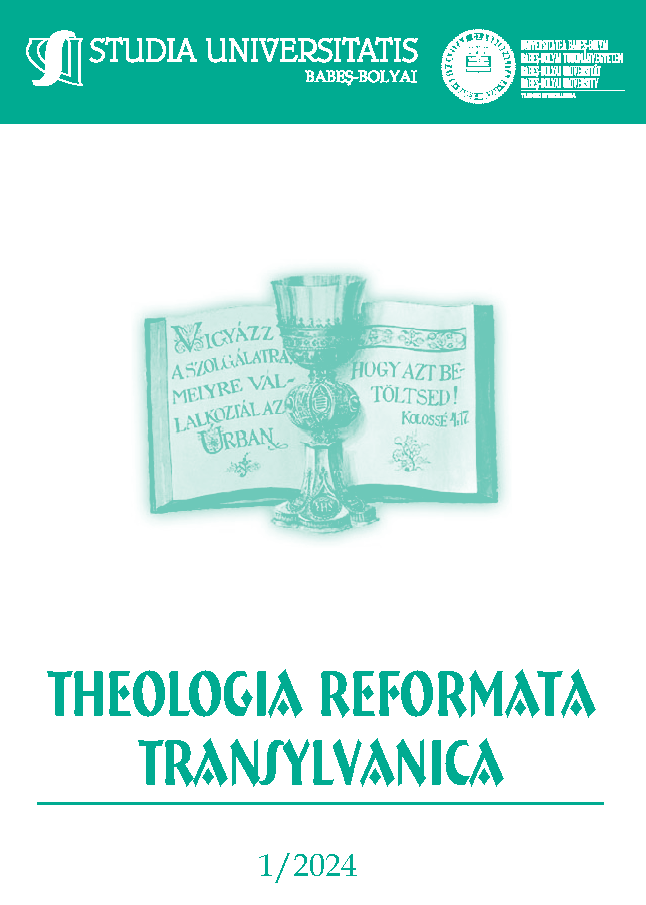Jákób, Lábán és az elő-ázsiai nomádok világa
DOI:
https://doi.org/10.24193/subbtref.69.1.01Keywords:
nomadism, patriarchal tradition, Jacob, the Book of Genesis, archaeology of the nomadsAbstract
Jacob, Laban, and the World of the Near Eastern Nomads
The following study looks at a well-known story from the Book of Genesis. Jacob is a central figure in the narratives describing the traditions of early Israel. The relevant text (Gen 29–31) tells the progenitor’s enrichment and growth from a solitary figure into an extensive clan. Our paper draws on the conceptual framework of the social dynamics of ancient Near Eastern nomadism to analyse some of the narrative’s features.
References
AHARONI, Y. (1982): The Archaeology of the Land of Israel. Philadelphia, Westminster Press.
AHLSTRÖM, G. (1993): The History of Ancient Palestine. Minneapolis, Fortress Press.
ALBRIGHT, W. F. (1961): Abram the Hebrew: A New Archaeological Interpretation, In: Bulletin of the American Schools of Oriental Research. 163. 36–54.
BARGE, O. (2020): Desert Kites. https://www.worldhistory.org/Desert_Kites/ (utolsó hozzáférés dátuma: 2024.03.06.).
BEKE, C. T. (1862): Notes on an Excursion to Harrān, in Padan-Aram, and Thence over Mount Gilead and the Jordan, to Shechem, In: The Journal of the Royal Geographical Society of London. 32. 76–100.
BENNETT, H. W. (1900): Genesis. Edinburgh, T.C. – E.C. Jack.
BETTS, A. (1989): The Solubba: Nonpastoral Nomads in Arabia, In: Bulletin of the American Schools of Oriental Research. 274. 61–69.
CLINES, D. J. A. (1993): The Dictionary of Classical Hebrew. Sheffield, Sheffield Academic Press. Vol. 1.
CRASSARD, R. – ABU-AZIZEH, W. – BARGE, O. – BROCHIER, J. E.– CHAHOUD, J. – RÉGAGNON, E. (2022): The Use of Desert Kites as Hunting Mega‑Traps: Functional Evidence and Potential Impacts on Socioeconomic and Ecological Spheres, In: Journal of World Prehistory. 35. 1–44.
CRIBB, R. (1991): Nomads in Archaeology. Cambridge, Cambridge Univ. Press.
DE VAUX, R. (1961): Ancient Israel. Its Life and Institutions. New York, McGraw.
FINKELSTEIN, I. (1995): Living on the Fringe: The Archaeology and History of the Negev, Sinai and Neighbouring Regions in the Bronze and Iron Ages. Sheffield, Sheffield Academic Press.
FINKELSTEIN, I. – PEREVOLOTSKY, A. (1990): Processes of Sedentarization and Nomadization in the History of Sinai and the Negev, In: Bulletin of the American Schools of Oriental Research. 279. 67–88.
HILLEL, D. (2006): The Natural History of the Bible. New York, Columbia Univ. Press.
HODOSSY-TAKÁCS E. (2011): The Concept of Covenant in the Ancient Near East and in Biblical Theology, In: Studia Theologica Debrecinensis. 4. 1. 21–32.
(2017): Clash and Coexistence in Ancient Palestine, In: Verebics É. P. – Móricz N. – Kőszeghy M. (szerk.): Ein pralles Leben: Alttestamentliche Studien Für Jutta Hausmann zum 65. Geburtstag und zur Emeritierung. Leipzig, Evangelische Verlangsanstalt. 343–352. (Arbeiten zur Bibel und ihrer Geschichte; 56.).
HOLLOWAY, S. W. (1995): Harran: Cultic Geography in the Neo-Assyrian Empire and Its Implications for Sennacherib’s “Letter to Hezekiah” in 2 Kings, In: The Pitcher Is Broken: Memorial Essays for Gösta W. Ahlström. JSOT Supp. 190. Sheffield, Sheffield Academic Press. 276–314.
KILLEBREW, A. E. (2005): Biblical Peoples and Ethnicity. Atlanta, SBL.
LLOYD, S. – BRICE, W. (1951): Harran, In: Anatolian Studies. 1. 77–111.
MALAMAT A. (1952): The Aramaeans in Aram Naharaim and the Rise of Their States (in Hebrew, with English title page). Jerusalem, Israel Exploration Society.
(1962): Mari and the Bible: Some Patterns of Tribal Organization and Institutions, In: Journal of the American Oriental Society. 82. 2. 143–150.
MATTHEWS, V. H. – BENJAMIN, D. C. (1993): Social World of Ancient Israel. Peabody (Mass.), Hendrickson.
MAZAR, B. (1969): The Historical Background of the Book of Genesis, In: Journal of Near Eastern Studies. 28. 2. 73–83.
OREN, E. D. – MORRISON, M. A. – GILEAD, I. (1986): Land of Gerar Expendition: Preliminary Report for the Seasons of 1982 and 1983, In: Bulletin of the American Schools of Oriental Research. Supplementary Studies. 24. 57–87.
PORTER, A. (2012): Mobile Pastoralism and the Formation of Near Eastern Civilizations. Cambridge, Cambridge University Press.
ROSEN, S. A. (1992): Nomads in Archaeology: A Response to Finkelstein and Perevolotsky, In: Bulletin of the American Schools of Oriental Research. 287. 75–85.
SAGGS, H. W. F. (1969): Neo-Babylonian Fragments from Harran, In: Iraq. 31. 2. 166–169.
SAID, E. W. (2000): Orientalizmus. Budapest, Európa Könyvkiadó.
SPEISER, E. (1963). The Wife-Sister Motif in the Patriarchal Narratives, In: Altmann, A. (szerk.): Biblical and Other Studies. Cambridge (MA) – London (England), Harvard University Press. 15–28.
TÓTH K. (1995): Mózes első könyvének magyarázata, In: Jubileumi Kommentár: A Szentírás magyarázata. Vol. 1. Budapest, Kálvin Kiadó. 139–183.
VARGA Gy. (2020): Nomád teológia. Budapest, Luther Kiadó.
VON RAD, G. (1972): Genesis. Commentary (revised edition). Philadelphia, The Westminster Press.
WAY, K. C. (2011): Donkeys in the Biblical World. Winona Lake (Indiana), Eisenbrauns.
WHYBRAY, R. W. (2007): Genesis, In: Barton, John – Muddiman, John (szerk.): The Oxford Bible Commentary. Oxford, Oxford University Press. 38–66.
Downloads
Published
How to Cite
Issue
Section
License
Copyright (c) 2024 Studia Universitatis Babeș-Bolyai Theologia Reformata Transylvanica

This work is licensed under a Creative Commons Attribution-NonCommercial-NoDerivatives 4.0 International License.



